Powerstroke vs Cummins: How to Choose Which Engine is Best for Your Needs
Jan 18th 2022
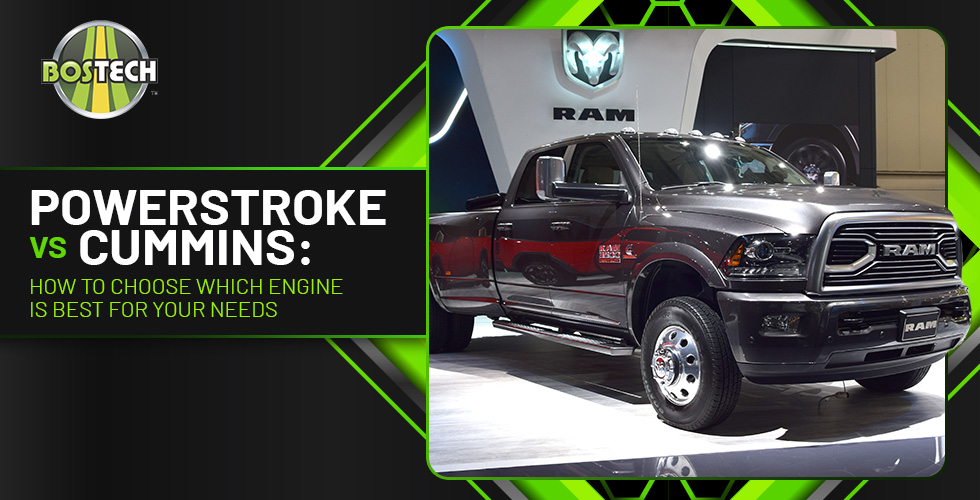
If you’re looking for a diesel engine with serious power, you’ll have to choose between the 6.7L Powerstroke V8 and the 6.7L Cummins Diesel I6, two of leading diesel engines on the market today. The Powerstroke is used in non-commercial Ford trucks, while the Cummins is found in RAM trucks. Both manufacturers have been steadily adding power and torque to their engines over the last few years in a bid to win over diesel lovers. Learn about the differences between Powerstroke vs Cummins to find the right type of engine for your needs.
The 6.7L Cummins Diesel I6
Cummins has been designing engines for over a hundred years, but these early models were mostly designed for farm work. The company partnered with RAM in 1989 to unveil the Cummins 5.9L Turbo Diesel. Thirty years later, the two are still collaborating and the engines keep getting more powerful. Cummins was the first use a turbocharger in a diesel engine when it released the 5.9-liter six-cylinder engine. It was eventually replaced with the 6.7L model in 2007 to help reduce noise and carbon emissions. The engine is also common in Dodge trucks as well as the Nissan Titan.
The 2021 6.7L Cummins Turbo Diesel offers more horsepower and torque than previous models. It is the most powerful engine for the RAM 2500 and 3500 pickup trucks. You can choose between the Standard Output and High Output version depending on your needs.
The Standard Output comes with the following specs:
- Horsepower: 370
- Torque: 850
- Bore: 107 mm (4.21 in)
- Stroke: 124 mm (4.88 in)
- Compression Ratio: 19:1
- Engine Weight: 1,071 lbs.
The High Output differs slightly and is only offered in the RAM 3500 when equipped with the Aisin transmission option. It features:
- Horsepower: 429
- Torque: 1,075
- Bore: 107 mm (4.21 in)
- Stroke: 124 mm (4.88 in)
- Compression Ratio: 16.2:1
- Engine Weight: 1,070 lbs.
Both the SO and HO options come with six cylinders and use the Bosch HPCR fuel system.
Replace the Diesel Particulate Filter on Your Cummins Engine
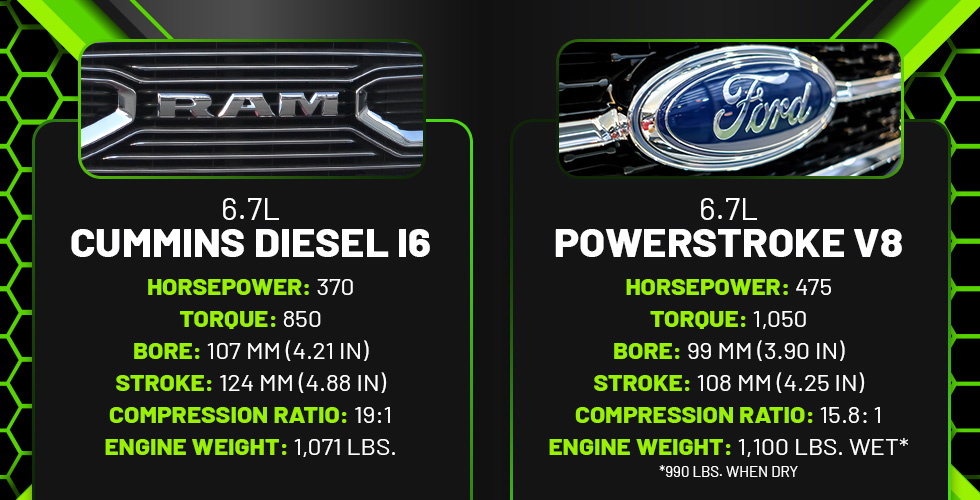
The 6.7L Powerstroke V8 Engine
Ford has been a titan in the American auto industry for nearly a century, but it wasn’t always the king of diesel like it is today. In the 80s, the company partnered with International Navistar to create the 6.9-liter IDI diesel engine followed by the 7.3L IDI engine. These engines ruled the diesel industry in their day, but things took a turn when the company launched the 6.0L Powerstroke to comply with the latest emissions regulations in the early 2000s.
The Environmental Protection Agency required automakers to reduce the amount of nitrogen-oxide in the diesel exhaust. To comply with these standards, the makers added an exhaust gas recirculation (EGR) system. This means the exhaust gas is reburned instead of leaving the exhaust. However, this lowers the temperature inside the compression chamber, which leads to an incomplete burn, causing soot to form.
The engine also uses an exhaust gas recirculation (EGR) cooler to reduce the amount of NOx in the exhaust. The exhaust gas is cooled before reentering the intake manifold, but the problem is that the factory 6.0 EGR cooler needs to be replaced often because the pipes will break and leak coolant in the engine or the exhaust, which can lead to long-term damage. You’ll need to find replacement 6.0 EGR coolers when using this type of engine.
The 6.0L was known to run into other problems as well. It uses a variable geometric turbo to make up for lost power, but the bolts on the cylinder heads will stretch out over time, causing the head gasket to leak. The soot from the EGR system can also clog the VGT.
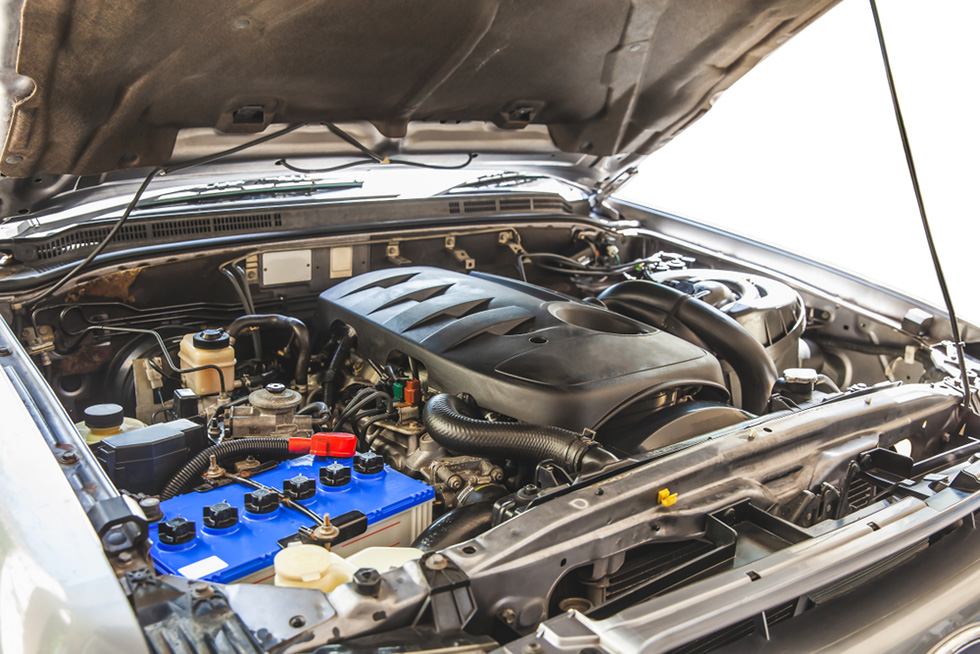
Ford eventually released the 6.7L Powerstroke engine in 2011 and has made additional upgrades since. It’s the first engine the company designed on its own without the help of International Navistar. However, the two are forming a joint venture to create commercial diesel vehicles. Going solo helped Ford create a diesel engine specifically designed to meet its vehicles’ needs.
The 6.7L Powerstroke diesel engine solves many of the problems consistent with the 6.0L. It comes with a revised variable geometric turbo, updated cylinder design, revised injection system, and a dual cooling system with a temperature circuit for the engine. Ford has made additional upgrades in the years since to improve power and performance. It is considered the most powerful engine for the Ford F-Series pickup trucks.
When Cummins upgraded its 6.7L Diesel I6 engine in 2019, all eyes were on Ford to see how the company would respond. The legendary automaker unveiled the third-generation 6.7L Powerstroke V8 Engine in 2020 to rave reviews. It comes with the following specs:
- Horsepower: 475
- Torque: 1,050
- Bore: 99 mm (3.90 in)
- Stroke: 108 mm (4.25 in)
- Compression ratio: 15.8: 1
- Engine Weight: 1,100 lbs. when wet, 990 lbs. when dry
Choosing Between Powerstroke vs Cummins
Now that you understand the history behind these two companies, you can start going through the features and specs that matter most. Everyone has a different agenda when finding a diesel engine. Both the Powerstroke and Cummins engines will serve you well as long as you have the latest model, but you’ll have to choose one over the other. Finding the perfect engine depends on how you plan on using the vehicle. Keep these factors in mind when making your decision:
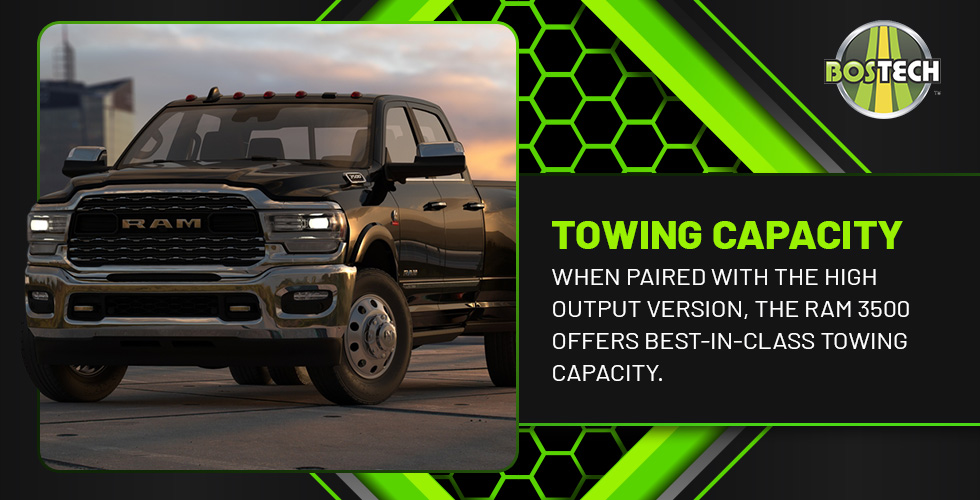
Powerstroke vs Cummins: Towing Capacity
Let’s start with towing capacity. If you’re looking for a diesel engine, chances are you plan on doing some heavy-duty towing. Both engines come with excellent towing capacity, but there are some slight differences to keep in mind.
The 6.7L Powerstroke engine can tow 15,000 lbs., but this number will vary based on the truck model and other factors that can affect towing capacity. The Ford F-Series can tow the following:
- 2020 Ford F-250 Towing Capacity: 18,200-lbs. max
- 2020 Ford F-350 Towing Capacity: 21,200-lbs. max
- 2020 Ford F-450 Towing Capacity: 24,200-lbs. max
As for the payload capacity, you’re looking at:
- 2020 Ford F-250 Payload Capacity: Up to 4,160 lbs.
- 2020 Ford F-350 Payload Capacity: Up to 7,850 lbs.
- 2020 Ford F-450 Payload Capacity: Up to 6,210 lbs.
You can notch that number up a bit if you shell out for the latest Ford towing package, but don’t expect to go over 26,000 lbs., which is the most the average truck owner can tow in the U.S. without a commercial driver’s license (CDL). That gives you plenty of power to haul trailers, boats, and whatever else you need to move.
These vehicles offer additional features that will help you tow with confidence, including Advancetrac® with Roll Stability Control and Trailer Sway Control, a trailer tire pressure monitoring system, trailer backup assist, trailer reverse guidance, and remote tailgate release.
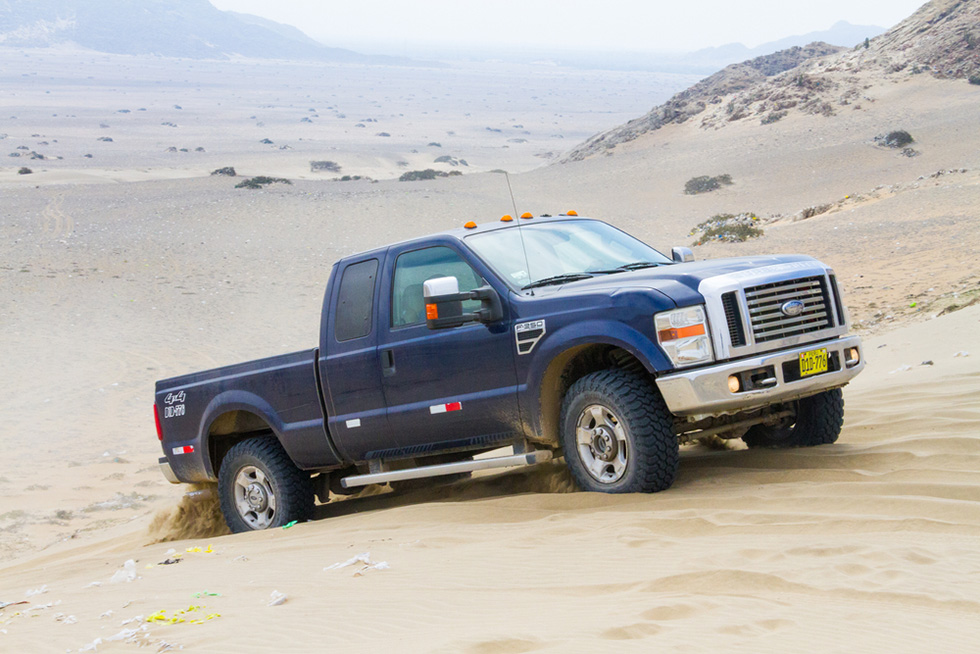
Now let’s look at the 6.7L Cummins Diesel I6. Again, the towing capacity will vary based on the model and build. RAM diesel engines can tow the following:
- RAM 2500 Towing Capacity: 19,680-lbs. max
- RAM 3500 Towing Capacity: 37,100-lbs. max
As for the payload, they offer:
- RAM 2500 Payload Capacity: Up to 3,160 lbs.
- RAM 3500 Payload Capacity: Up to 6,570 lbs.
When paired with the High Output version, the RAM 3500 offers best-in-class towing capacity. Clearly, RAM has the edge over Ford when it comes to towing, but you may not need room for those extra pounds unless you have a CDL. Consider the weight of everything you will need to tow, the size of your trailer, and other variables when choosing a towing capacity.
RAM has included a slew of safety features to help you navigate the road as well, including a 360º Surround View Camera with trailer reverse guidance view, which uses five cameras to show everything that’s happening around the truck. It also comes with a trailer light check and trailer tire pressure monitoring system. It can also automatically lower or raise the trailer for easy unloading.
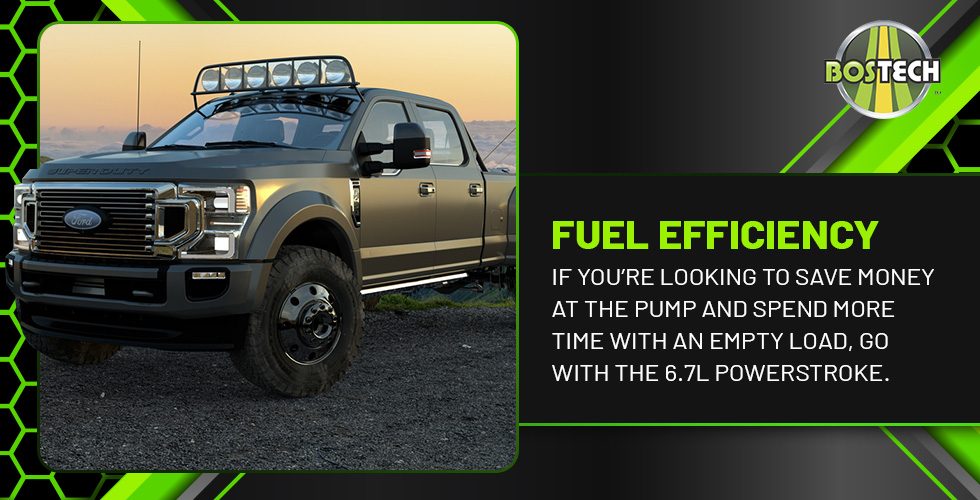
Powerstroke vs Cummins: Fuel Efficiency
Fuel efficiency may not be at the top of your list, especially if you use your truck for work, but finding a fuel-efficient diesel engine will help you save money in the long run. The good news is that you shouldn’t have to sacrifice power.
When it comes to the 6.7L Powerstroke, expect to get around 19.2 mpg, which is fairly impressive for the diesel industry. However, this figure will vary based on the model of the vehicle and the payload. It can drop down to 11.2 mpg when the load is full and can go up to 22.5 mpg when empty. It marks an 18% increase in fuel mileage over previous 6.4L engines. It also supports the use of B20 biodiesel fuel, up to 20% biodiesel and 80% petroleum diesel, for less impact on the environment.
As for the 6.7L Cummins, the fuel economy will vary based on the model and trim. Expect to get around 12 mpg in the city and 18 mpg on the highway. A full load will bring that down to around 11.2 mpg, while an empty load will give you about 14.2 mpg. It also works with B20 biodiesel fuel.
If you’re looking to save money at the pump and spend more time with an empty load than a full one, consider going with the 6.7L Powerstroke over the Cummins.
Powerstroke vs Cummins: Maintenance
Consider how well the vehicle and engine will perform over time when making your decision. Let’s start with the warranty, which is a good sign of how long the vehicle will last.
Cummins recently announced it’s offering a comprehensive three-year warranty for the 6.7L diesel engine, which includes travel and towing.
However, Ford has them beat. The 6.7L Powerstroke comes with a five-year/250,000-mile warranty for lasting peace of mind.
When it comes to reliability, the Cummins engine has a better reputation than the Powerstroke. However, Ford trucks tend to be more reliable than RAM.
That’s not to say these engines are immune to wear and tear. Both models can present issues after a while.
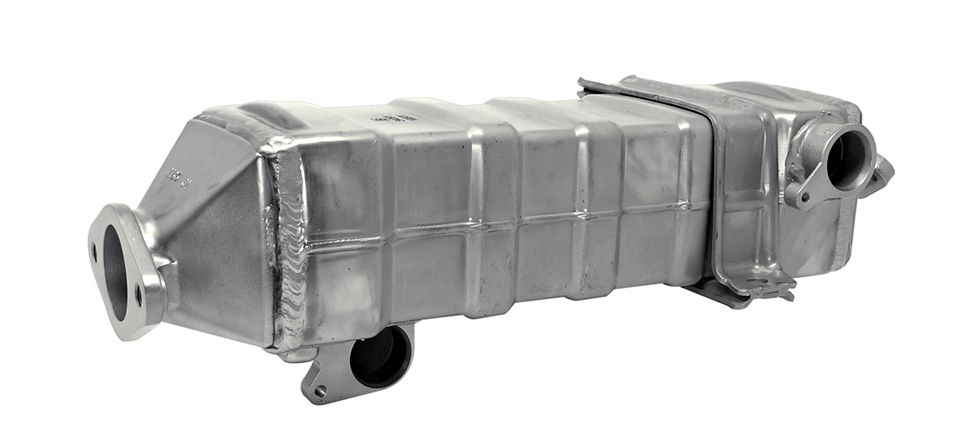
When it comes to the 6.7L Powerstroke, older models are likely to fail than the 2020 version. You may see the injection pump fail over time as the metal collides with other metal. The 2011 model was known for its bad spark plugs, but the issue has since been resolved. The EGR cooler on the 6.7L is much better than the previous version, but it can still fill up with soot. You’ll need to find a replacement 6.7 EGR cooler to repair the cooling system.
The 6.7L Cummins is a little more durable, but it still has its fair share of issues. The diesel particulate filter can get clogged with soot and other debris. The turbo and gasket heads can also fail after excess towing. The engine uses a unique one-piece sliding nozzle that continuously moves to vary the power of the turbine and the amount of air delivered to the engine. Instead of having the vanes of the turbo pivot, which is the standard in the industry, it uses an electronically controlled actuator to position the sliding nozzle ring over the vanes to adjust exhaust pressure. While effective, the VGT has been known to stick over time. The bearings will also wear down if you use the turbo too much.
The EGR cooler on the Cummins engine can also fail. It will clog with soot and other particles over time. Cleaning it can help relieve these issues, but it’s best to replace it every 80,000 to 100,000 miles. You can find a replacement Cummins EGR cooler online to solve the problem.
There are so many factors to consider when choosing between a Cummins and Powerstroke engine. They are comparable in terms of horsepower and torque as these manufacturers try to outdo one another. Take this information with you as you look for the best diesel engine money can buy.
Image Credits
Puririy/Shutterstock.com
sommai damrongpanich/Shutterstock.com
Mike Mareen/Shutterstock.com
KULLAPONG PARCHERAT/Shutterstock.com
meowKa/Shutterstock.com
Majrandy/Shutterstock.com
